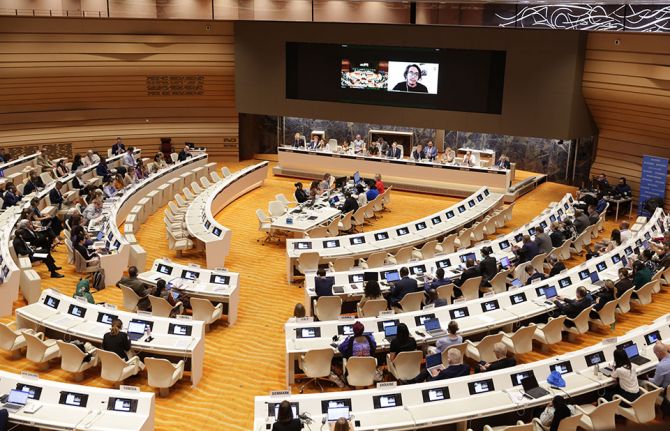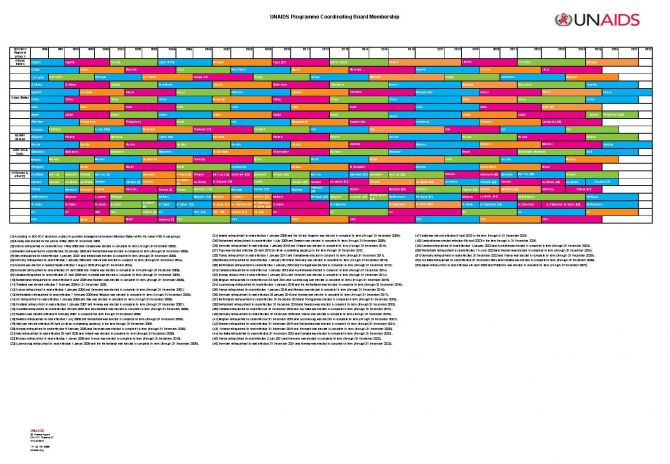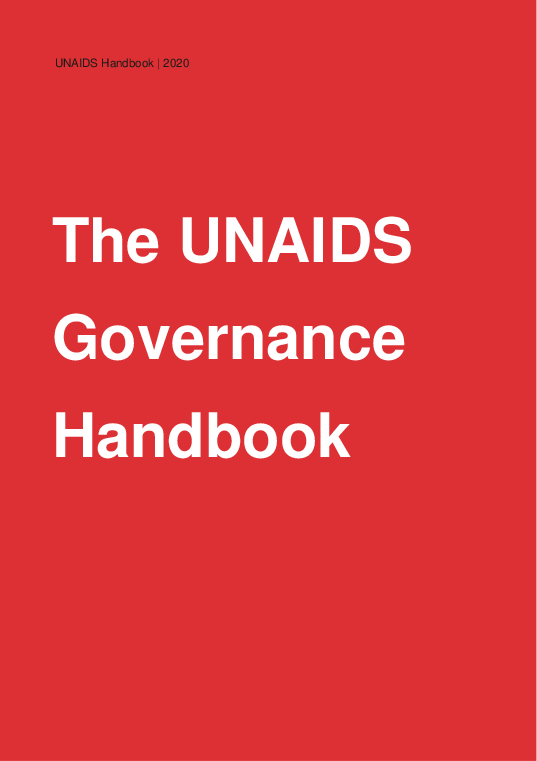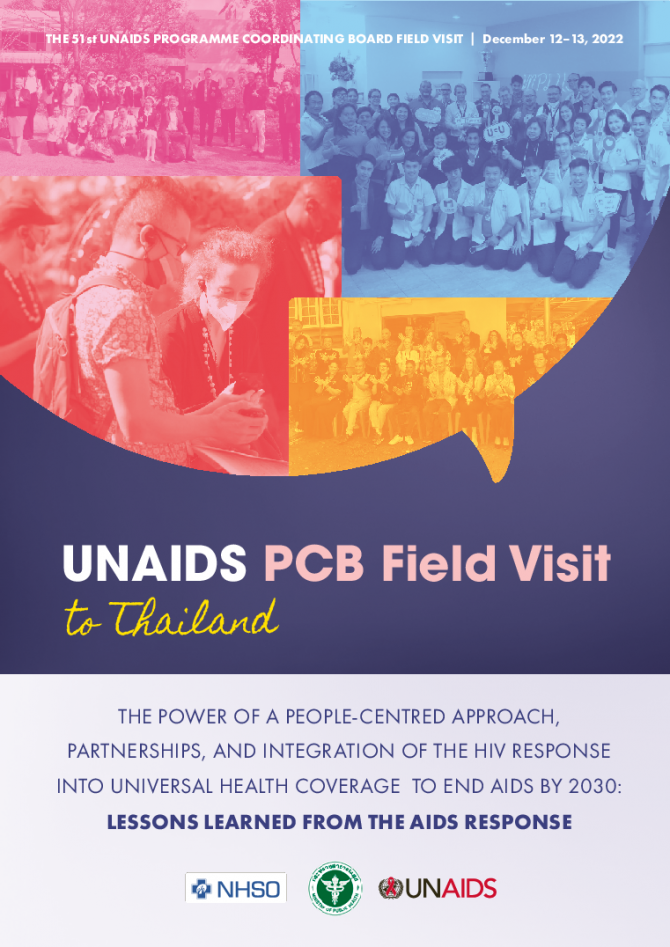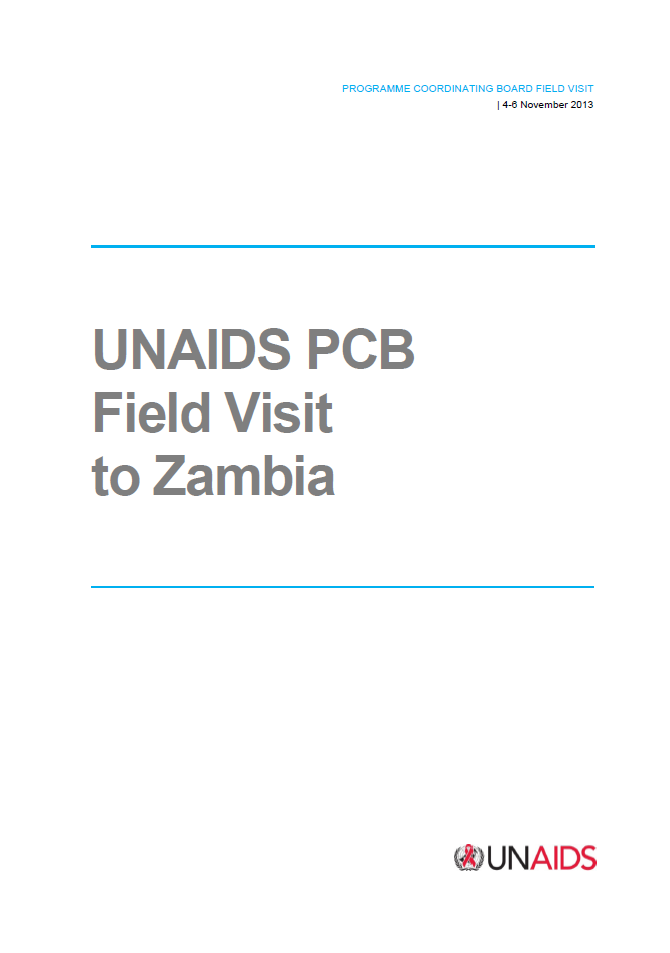
About
Governance
Accelerating progress and holding stakeholders accountable in achieving the Sustainable Development Goals demand inclusive and cross-sector governance at the global and country levels. The AIDS response has been a pioneer in establishing inclusive governance mechanisms, including the Joint Programme.
UNAIDS was established by the United Nations Economic and Social Council (ECOSOC) and remains the only cosponsored joint programme of the United Nations system. The Joint Programme is guided by its Programme Coordinating Board (PCB), a governance structure unique in its small size and its level of inclusiveness, with Member States, Cosponsors and civil society, and specifically people living with and affected by HIV, as PCB members. Its constituency structure and openness to granting observer status further enhances inclusiveness. The PCB’s agenda includes a standing item on leadership that allows for high-level guest speakers to address the PCB on critical issues in the AIDS response. The two-day PCB meetings are complemented by a day-long thematic session that fosters dialogue on key topics.
UNAIDS’ inclusive governance model has been recognized by ECOSOC as a lesson learned for the United Nations system for progress in the sustainable development era. This multistakeholder composition has also influenced other multilateral mechanisms, such as Gavi, the Vaccine Alliance, the Global Fund to Fight AIDS, Tuberculosis and Malaria and Roll Back Malaria.
The Committee of Cosponsoring Organizations (CCO) gathers Cosponsor heads of agencies and facilitates the input of Cosponsors into the strategy, policies and operations of the Joint Programme. The CCO is also tasked with ensuring that relevant PCB decisions are discussed by the Cosponsors’ respective boards and that relevant objectives in UNAIDS’ global-level results frameworks are incorporated into Cosponsors’ results frameworks.
ECOSOC
UNAIDS was established through ECOSOC resolution 1994/24 of 26 July 1994 to undertake a joint and cosponsored United Nations programme on HIV on the basis of co-ownership, collaboration, planning and execution and an equitable sharing of responsibility with six cosponsoring United Nations organizations (the United Nations Development Programme, the United Nations Children’s Fund, the United Nations Population Fund, the World Health Organization, the United Nations Educational, Scientific and Cultural Organization and the World Bank). This group was joined by the United Nations Office on Drugs and Crime in 1999, the International Labour Organization in 2001, the World Food Programme in 2003, the Office of the United Nations High Commissioner for Refugees in 2004 and UN Women in 2012. UNAIDS is now composed of 11 United Nations organizations and the UNAIDS Secretariat.
Six programme objectives for UNAIDS were listed in ECOSOC resolution 1994/24:
- To provide global leadership in the response to the HIV epidemic.
- To achieve and promote global consensus on HIV policy and programme approaches.
- To strengthen the capacity to monitor trends in HIV and ensure that appropriate and effective policies and strategies are implemented at the country level.
- To strengthen the capacity of national governments to develop comprehensive national HIV strategies and implement effective activities.
- To promote broad-based political and social mobilization to prevent and respond to HIV.
- To advocate greater political commitment for the response to HIV at the global and country levels, including the mobilization and allocation of adequate resources.
UNAIDS reports to ECOSOC on a biannual basis through the Report of the Executive Director of UNAIDS, transmitted to ECOSOC by the United Nations SecretaryGeneral. It is practice that the Chair and Vice-Chair of the PCB cofacilitate the development of a resolution on the Joint Programme.
UNAIDS governance has been recognized by the 54 Member States of ECOSOC in ECOSOC resolutions as a model for the United Nations system for implementation of the Sustainable Development Goal agenda.
In resolution E/2017/L.27 in 2017, ECOSOC stated that it, “Recognizes the critical importance of the Joint Programme in actively contributing to and engaging in the follow-up and review process of progress on the 2030 Agenda, including at the high-level political forum, to ensure that adequate attention is given to the HIV and AIDS response and its interlinkages with the other Sustainable Development Goals and targets.”
In resolution E/RES/2013/11 in 2013, ECOSOC stated that it, “Recognizes the value of the lessons learned from the global HIV and AIDS response for the post-2015 development agenda, including the lessons learned from the unique approach of the Joint Programme.” It also stated that it, “Recognizes that the Joint Programme offers the United Nations a useful example to be considered, as appropriate, as a way to enhance strategic coherence, coordination, results-based focus and country-level impact, based on national contexts and priorities, in accordance with General Assembly resolution 67/226 of 21 December 2012 on the quadrennial comprehensive policy review of operational activities for development of the United Nations system.”
General Assembly
The General Assembly is the main deliberative, policy-making and representative body of the United Nations. All 193 Member States of the United Nations are represented in the General Assembly, at which they discuss, and work together on, a wide array of international issues covered by the United Nations Charter. In September, all Member States meet for the annual General Assembly session.
In September 2015, the General Assembly agreed on a set of 17 Sustainable Development Goals, contained in the outcome document of the United Nations summit for the adoption of the post-2015 development agenda (resolution 70/1).
In 2001, 2006, 2011 and 2016, the General Assembly convened high-level meetings on HIV in order to undertake a comprehensive review of the progress achieved, including the successes, best practices, lessons learned, obstacles, gaps, challenges and opportunities, and to make recommendations to guide and monitor the AIDS response.
The 2016 United Nations Political Declaration on Ending AIDS was the first political declaration to be committed to after the adoption of the Sustainable Development Goal. Its commitments are far-reaching and include concrete strategies for action to end the AIDS epidemic by 2030 as part of the Sustainable Development Goals.
2016 United Nations Political Declaration on Ending AIDS
United Nations Member States committed to implementing a bold agenda to end the AIDS epidemic by 2030 during the United Nations General Assembly High-Level Meeting on Ending AIDS, held in New York, United States of America, from 8 to 10 June 2016. The progressive, new and actionable Political Declaration includes a set of specific time-bound targets and actions that must be achieved by 2020 if the world is to get on the Fast-Track and end the AIDS epidemic by 2030 within the framework of the Sustainable Development Goals.
2011 United Nations Political Declaration on HIV and AIDS
The United Nations General Assembly High-Level Meeting on HIV and AIDS in 2011 provided an opportunity to take stock of the progress and challenges of the past 30 years and shape the future AIDS response, 10 years after the historic 2001 United Nations Special Session on HIV/AIDS and after the 2006 signing of the Political Declaration, in which United Nations Member States committed to moving towards universal access to HIV prevention, treatment, care and support.
2006 United Nations Political Declaration on HIV/AIDS
In 2006, a Political Declaration on HIV/AIDS was adopted unanimously by United Nations Member States at the close of the High-Level Meeting on HIV/AIDS. It provided a strong mandate to help move the AIDS response forward, with scaling up towards universal access to HIV prevention, treatment, care and support. It also reaffirmed the 2001 Declaration of Commitment and the Millennium Development Goals, in particular the goal to halt and begin to reverse the AIDS epidemic by 2015.
2001 Declaration of Commitment on HIV/AIDS
In 2001, heads of state and government and representatives of 189 nations gathered at the Special Session of the United Nations General Assembly on HIV/AIDS. They unanimously adopted the Declaration of Commitment on HIV/AIDS, acknowledging that the AIDS epidemic constitutes a “global emergency and one of the most formidable challenges to human life and dignity.” The Declaration of Commitment covers 10 priorities, including prevention, treatment and funding.
Security Council
Under the United Nations Charter, the United Nations Security Council has primary responsibility for maintaining international peace and security and may meet whenever peace is threatened. It has 15 members, and each member has one vote. Under the United Nations Charter, all Member States are obligated to comply with Security Council decisions.
In January 2000, the United Nations Security Council made history when for the first time it debated a health issue—AIDS. Security Council resolution 1308, adopted on 17 July 2000, was the first to address a global public health threat to international peace and security. Bearing in mind the Security Council’s primary responsibility for peace and security, the resolution recognized that the AIDS epidemic is exacerbated by violence and instability and stressed that the epidemic, if left unchecked, may pose a risk to stability and security.
Cosponsor governing bodies
Cosponsors report to their respective boards on their work on HIV within their own reporting frameworks. This reporting also draws the attention of Cosponsor governing bodies to the decisions made by the PCB. To improve coherence, the UNAIDS Secretariat is invited to participate in relevant discussions of Cosponsor boards. Cosponsor heads of agencies are supported to ensure that relevant AIDS policy decisions made by the PCB are brought forward for substantive discussion by their boards.
The CCO, which is composed of the heads of agencies of the UNAIDS Cosponsors, is tasked with ensuring that relevant PCB decisions are discussed by the Cosponsors’ respective boards and that relevant objectives in UNAIDS’ global-level results frameworks are incorporated into Cosponsors’ results frameworks. As a regular agenda item, the CCO systematically engages in discussions on UNAIDS’ strategy.
To further facilitate continuity and accountability, the UNAIDS Executive Director co-chairs CCO meetings. The Cosponsor Co-Chair and the UNAIDS Executive Director jointly manage the agenda of the CCO.
Building on the Executive Director’s reports to the PCB, which report on the priority issues and outcomes of CCO discussions, the Executive Director prepares and submits a report for the United Nations Secretary-General on CCO conclusions, as a contribution to United Nations reform and in line with the recommendations of the Quadrennial Comprehensive Policy Review.
Read more
Stories
Publications
GOVERNANCE KEY DOCUMENTS
FIELD VISIT REPORTS
Related resources






